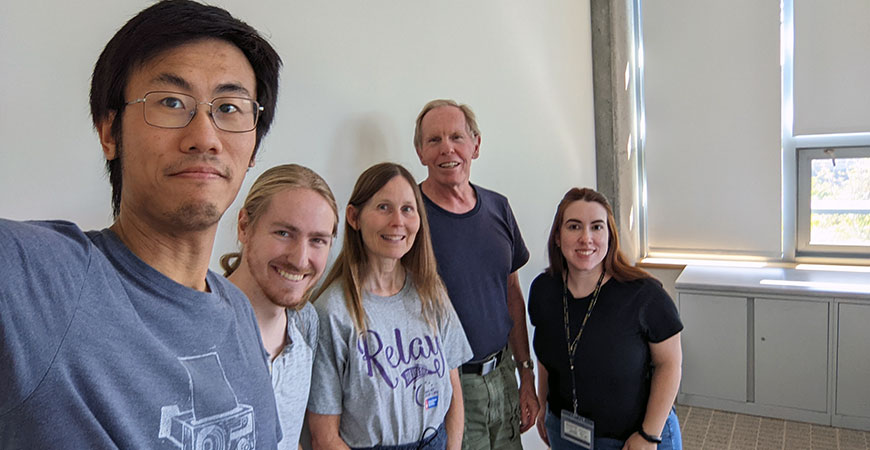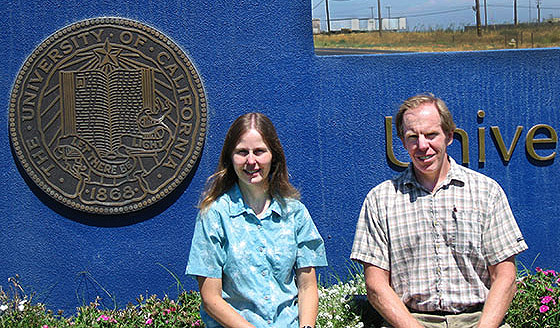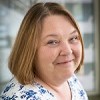
Starting a university from scratch isn’t for the faint of heart — or the slow of foot. Lucky for UC Merced, Anne Myers Kelley and David Kelley are neither.
Anne, a former Olympic marathon trials qualifier, and David, a competitive cyclist, were no strangers to long, grueling efforts when they packed up their lab gear and headed west from Kansas State University in 2003.
They weren’t just changing jobs — they were helping build a university from the ground up. Now, more than two decades, hundreds of students, and countless research hours later, the founding duo is gearing up for a slower-paced adventure.
Well, maybe just a little slower now that they are retiring.
The Kelleys’ footprints are all over the School of Natural Sciences, particularly in the Department of Chemistry and Biochemistry, a keystone research area for UC Merced’s rise to an R1 university designation.
Building Labs and a Department
“I said they were very brave to come here when there was nothing, but Anne said that it wasn't bravery at all; they were overjoyed at being able to find two senior positions in the same field of experimental physical chemistry at a research university in California,” Professor Christine Isborn said.
Anne and David Kelley were the fourth and fifth faculty members hired. As experimental physical chemists, they came prepared for hands-on work, and they got it.
“They gave us very nice little offices and these big open spaces and said, ‘Here are your labs,’” Anne said. “It was like being asked to build a lab in our garage. We just unloaded the moving truck and got to work.”
Beyond their labs, the Kelleys were central to shaping what eventually became the department — developing the curriculum, building its structure and policies and hiring faculty.
“One of the things that has been rewarding is helping to build a really strong program in theoretical and computational chemistry here,” Anne said. “We have managed to hire some exceptional people who have performed very well.”
“Doing faculty searches every year is hard work, but also fun and interesting,” she added. “It makes you feel like you’re moving forward and things are improving.” Professors Andy and Patti LiWang were among their first hires. Anne said they have been instrumental in building the biochemistry program.
Patti LiWang said Anne often took on administrative duties so junior faculty had more time to teach, research and flourish.
“Anne put in countless hours of service for the department, school and campus. Some years, she’d drive to Oakland for UC meetings, return for campus business, and teach — all within a day or two,” she said.
“At times, it seemed like she was the only one keeping the department going.”
Isborn praised Anne’s approach as department chair.
“What I appreciated most about her as chair was that she didn’t use her position to push the department in her direction,” she said. “She’d state her opinion, listen respectfully to other perspectives, and work collaboratively to decide how the department should move forward.”
David brought the same depth and commitment to his role. Although he declined to hold administrative positions, he was active in service to the department and the campus, including chairing and serving on many faculty search committees as well as in the Academic Senate. He also maintained an active, well-funded research group, advised a number of successful Ph.D. students and published extensively in well-regarded journals.
“Dave has an amazing breadth and depth of physical chemistry knowledge,” Isborn said. “He is famous within the department for asking tough, but interesting, questions of every seminar speaker, always sitting in the front row and making little notes on a napkin.”
He’s also known for his trademark “Question Authority” T-shirt — often worn while practicing just that.
Rigorous and Respected
The Kelleys are not just researchers, teachers and mentors; they are part of the university’s bedrock.
“They were very proud to come here and help start the first research university of the 21st century,” Patti LiWang said.
They are also standard bearers.
 “They are committed to academic rigor. They expect a lot of themselves, of their colleagues and their students, but they are also supportive,” said Department Chair Professor Ryan Baxter. “I think it's difficult for most people to have both of those characteristics at the same time.
“They are committed to academic rigor. They expect a lot of themselves, of their colleagues and their students, but they are also supportive,” said Department Chair Professor Ryan Baxter. “I think it's difficult for most people to have both of those characteristics at the same time.
“They have very well-thought-out reasons for their opinions. But if someone raises a point that makes them reconsider, they're quick to acknowledge it. That's really admirable.”
The Kelleys are known for their keen intelligence, even in a department full of brilliant people.
“One year, Anne was running the department while keeping the Academic Senate functioning. She had not only multiple papers, but some of them were single-author papers, meaning she collected all the data herself in the lab,” Patti LiWang said.
“If it wasn’t obvious before, it was obvious then: The woman is brilliant.”
Laser Labs and Sharp Minds
Anne is best known in her field for pioneering new techniques in resonance Raman spectroscopy and related areas — powerful tools for understanding molecular behavior.
Her methods, as Baxter explained, are critical for investigating high-speed photochemical processes, such as the way the eye processes light.
“Her work is fundamental to understanding these types of properties, but the applications of it are widespread,” he said. “Many scientists can use the information she developed through her techniques to gain a deeper understanding of systems that involve photochemical processes.”
“She is very well-known in the spectroscopy community,” Isborn said. “I remember reading some of her papers as a grad student.”
Early in her time at UC Merced, Anne was focused on organic molecules. Meanwhile, David had established a well-regarded research program on the ultrafast photophysics of semiconductor quantum dots.
Eventually, the potential overlap was too interesting to ignore.
“I gradually started working on the same stuff that he works on,” Anne said. “We’ve pretty much had combined and very collaborative research programs for the past 10 years or so.”
David has also established long-standing relationships with industry partners, such as Nanosys, a company working on light-emitting nanoparticles.
“It has been a terrific collaboration,” David said. “They provide world-class synthetic expertise, and we were able to secure a very large industrial/academic Department of Energy grant that has funded a good part of the work that both my group and Anne’s has done over the past several years. Very much a win-win situation.”
“Much of his fundamental work helps industry partners refine the application space they're exploring and develop better devices,” Baxter said.
Up until a couple of years ago, Anne said she was doing a fair amount of lab work herself.
“Most faculty at my career stage never go into the lab anymore,” she said. “I’m glad I have kept the ability to go in there and do it myself. Doing research is always fun.”
Retirement doesn’t mean being involved in science is over for either of the Kelleys. Anne just began a four-year leadership term with the American Physical Society.
“I’m vice chair of the Division of Chemical Physics,” she said. “For the next four years, I will have something keeping me active in science.”
David plans to stay engaged in science by continuing his consulting activities. He is actively involved in several research projects at Nanosys that may result in dramatic advancements in display technology.
New Trails Ahead
Retirement will open up time for their continuing athleticism.
Anne, once a fixture on the Central Valley marathon and half-marathon scene, still runs and races regularly, albeit at a slower speed these days.
David is still a strong enough cyclist to “terrorize” riders a third his age, Anne said.
“Among bikers, people want to know who the big dog is,” Patti LiWang said. “That is still Dave Kelley.”
They have reached emeritus status, but the Kelleys will continue to mentor one graduate student each over the next year or so. After that? The mountains are calling.
And for the first time in more than 20 years, they will be able to take advantage of peak Sierra backpacking season — mid-August through September.
“We don’t know exactly where we’ll live,” Anne said. “We’re looking at somewhere in the eastern suburbs of Sacramento, maybe the Auburn area. We want to stay close to the Sierras for backpacking and hiking.”
They’re looking forward to a life where hiking boots and bike tires are more useful than lab coats, but not alone.
“Our dogs love to go backpacking with us,” Anne said.
The couple consider their dogs their kids, colleagues said. At their retirement party, they were presented with laser etchings of photos of their pups.
A student also gave David a copy of the book “The Last Man Who Knew Everything: The Life and Times of Enrico Fermi.”
“Dave seemed very happy with the book because he aspires to know everything as part of his retirement,” Isborn said.
The Kelleys might have crossed the finish line of one marathon, but they’re learning the route for their next one.
Only this time, the map is all theirs.
Lorena Anderson

Senior Writer and Public Information Representative
Office: (209) 228-4406
Mobile: (209) 201-6255






